Related Research Articles

Dessert is a course that concludes a meal. The course consists of sweet foods, such as confections, and possibly a beverage such as dessert wine and liqueur. In some parts of the world, such as much of Central Africa and West Africa, and most parts of China, there is no tradition of a dessert course to conclude a meal.
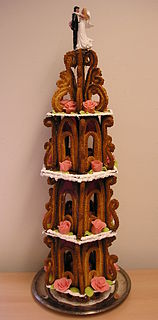
Confectionery is the art of making confections, which are food items that are rich in sugar and carbohydrates. Exact definitions are difficult. In general, however, confectionery is divided into two broad and somewhat overlapping categories: bakers' confections and sugar confections. The occupation of confectioner encompasses the categories of cooking performed by both the French patissier and the confiseur.
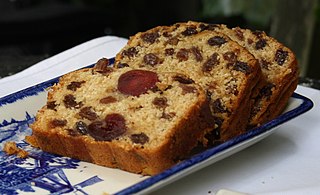
Fruitcake is a cake made with candied or dried fruit, nuts, and spices, and optionally soaked in spirits. In the United Kingdom, certain rich versions may be iced and decorated.

A falooda is a Mughlai Indian version of a cold dessert made with noodles. It has origins in the Persian dish faloodeh, variants of which are found across West, Central, and South Asia. Traditionally it is made by mixing rose syrup, vermicelli, and sweet basil seeds with milk, often served with ice cream. The vermicelli used for preparing falooda is made from wheat, arrowroot, cornstarch, or sago.

Eton mess is a traditional English dessert consisting of a mixture of strawberries or other berries, meringue, and whipped cream. First mentioned in print in 1893, it is commonly believed to originate from Eton College and is served at the annual cricket match against the pupils of Harrow School. Eton mess is occasionally served at Harrow School, where it is referred to as Harrow mess.

Sorbet, also called "water ice", is a frozen dessert made using ice combined with fruit juice, fruit purée, wine, liqueur, honey and etc. Generally sorbets do not contain dairy ingredients, while the sherbets do.

Dobos torte, also known as Dobosh, is a Hungarian sponge cake layered with chocolate buttercream and topped with caramel. The layered pastry is named after its inventor, Hungarian chef József C. Dobos, a delicatessen owner in Budapest. In the late 1800s, he decided to create a cake that would last longer than other pastries in an age when cooling techniques were limited. The round sides of the cake are coated with ground hazelnuts, chestnuts, walnuts, or almonds, and the hardened caramel top helps to prevent drying out, for a longer shelf life.
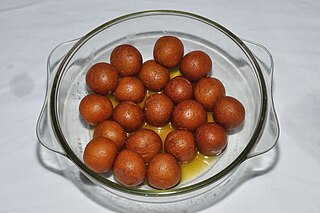
Pantua is a local confection from the Indian subcontinent, notable in West Bengal, Eastern India and Bangladesh. It is a traditional Bengali sweet made of deep-fried balls of semolina, chhena, milk, ghee and sugar syrup. Pantuas range in colour from pale brown to nearly black depending on how long they are fried. Rose water, cardamom or other flavourings are sometimes added to the sweet.

Fruit soup is a soup prepared using fruit as a primary ingredient, and may be served warm or cold depending on the recipe. Some fruit soups use several varieties of fruit, and alcoholic beverages such as rum, sherry and kirsch may be used. Fruit soup is sometimes served as a dessert.

Frozen dessert is a dessert made by freezing liquids, semi-solids, and sometimes even solids. They may be based on flavored water, on fruit purées, on milk and cream, on custard, on mousse (semifreddo), and others. It is sometimes sold as ice-cream in South Asia and other countries.

Crème brûlée or crème brulée, also known as burnt cream or Trinity cream, and virtually identical to the original crema catalana, is a dessert consisting of a rich custard base topped with a layer of hardened caramelized sugar. It is normally served slightly chilled; the heat from the caramelizing process tends to warm the top of the custard, while leaving the center cool. The custard base is traditionally flavored with vanilla in French cuisine, but can have other flavorings. It is sometimes garnished with fruit.
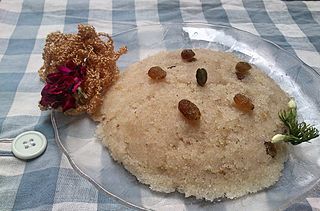
Suji is a type of halvah made by toasting semolina in a fat like ghee or oil, and adding a sweetener like sugar syrup or honey. It can be served for breakfast or as a dessert item. The basic recipe is made with just semolina, sugar or honey, ghee, and sometimes milk. Variations on this include dried or fresh fruits, nuts, shredded coconut, and other toppings.

Palatschinken is a thin crêpe-like variety of pancake of Greco-Roman origin. While the dessert is most common in South and West Slavic countries, it is also generally known in other parts of Central and Eastern Europe. Names of the dish include palaçinka (Albanian), Palatschinke, palačinka, palacinka (Slovak), palačinka (Czech), палачинка, налисник (Ukrainian), naleśnik (Polish), clătite (Romanian), palacinta or palacinca (Italian) and palacsinta (Hungarian).
Karydopita is a Greek dessert cake made primarily from walnuts and covered in a sweet syrup. Its name is a compound word which derives from "karýdia" and "pita".

Darra Goldstein is an American author and food scholar who is the Willcox B. and Harriet M. Adsit Professor of Russian, Emerita at Williams College.
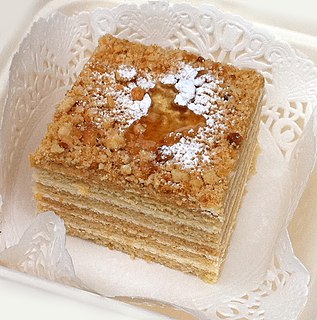
Medovik is a layer cake popular in countries of the former Soviet Union. The identifying ingredients are honey and smetana or condensed milk.

Guryev porridge is a Russian sweet porridge (kasha) prepared from semolina and milk with the addition of candied nuts, honey and dried fruits.
Leach was a popular medieval sweetmeat (confection) consisting of a thick, jelly-like preserve which set hard enough to be sliced for serving.

Zalabiyeh or Pitulici is a fritter or doughnut found in several cuisines across Europe, the Middle East and West Asia. The fritter version is made from a semi-thin batter of wheat flour which is poured into hot oil and deep-fried. The earliest known recipe for the dish comes from a 10th-century Arabic cookbook and was originally made by pouring the batter through a coconut shell. Zalabiyeh is also the Arabic language term used by Mizrahi Jews for a deep-fried yeast dough, often topped with either honey or syrup, and known as burmuelos in Ladino.
Amygdalopita is an almond cake in Greek cuisine made with ground almonds, flour, butter, eggs and pastry cream. It is one of the most common glyka tapsiou - dessert dishes like pies and breads baked in baking pans. Other common desserts of this style are galaktoboureko, karydopita and kadaifi.
References
- ↑ Hannele Klematillā, 'Sucket', Darra Goldstein, The Oxford Companion to Sugar and Sweets (Oxford, 2015), p. 662.
- ↑ Arthur Collins, Jewels and Plate of Elizabeth I (London, 1955), pp. 430 no. 814, 433 no. 832, 584 no. 1558, 591-2 no. 1581.
- ↑ Phillipa Glanville, 'Sucket fork', Darra Goldstein, The Oxford Companion to Sugar and Sweets (Oxford, 2015), p. 661.
- ↑ John Nichols's The Progresses and Public Processions of Queen Elizabeth, vol. 1 (Oxford, 2014), p. 244.
- ↑ British Library, Mary, Queen of Scots: two new acquisitions